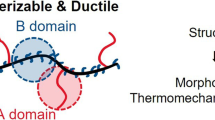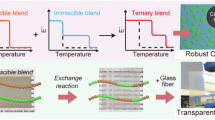Abstract
Long-chain branched-polypropylene (LCB-PP) was prepared by melt grafting, and LCB-PP/silicate composites were prepared by adding 1–7 wt% silicate using a mini-compounder at 190 °C. The chemical structure of the LCB-PP was confirmed by the existence of a –C=C–H-stretching peak at 3100, cm−1 in the Fourier transform infrared spectrum. LCB-PP and the LCB-PP/silicate composites exhibited unusual rheological properties, including high shear-thinning tendency and elasticity. Shear-thinning tendency and elasticity were highest in the composite containing 5 wt% silicate. These effects were confirmed by oscillatory rheological measurements. The crystallization behavior of LCB-PP and the silicate composite were investigated using a non-isothermal process proposed by Ozawa. The exothermic pattern of the composite is narrower and sharper than those of PP and branched PP. The extending exponents were 3.6 for PP, 2.4 for LCB-PP and 1.5 for the composite. These behaviors can be interpreted by speculating that the silicate in the PP matrix functions as a seed for crystallization and alters the crystallization process.
Similar content being viewed by others
Log in or create a free account to read this content
Gain free access to this article, as well as selected content from this journal and more on nature.com
or
References
Jung, H. W., Lee, J. S., Kim, W. N. & Hyun, J. C. Study on rheological properties of polypropylene/polycarbonate blends. Korean J. Rheol. 8, 119 (1996).
Li, S., Xiao, M., Wei, D., Xiao, H., Hu, F. & Zheng, A. The melt grafting preparation and rheological characterization of long chain branching polypropylene. Polymer 50, 6121 (2009).
Borsig, E., van Duin, M., Gotsis, A. D. & Picchioni, F. Long chain branching on linear polypropylene by solid state reactions. Euro. Polym. J. 44, 200 (2008).
Tsenoglou, C. J. & Gotsis, A. D. Logical characterization of long chain branching in a melt of evolving molecular architecture. Macromolecules 34, 4685 (2001).
Tian, J., Yu, W. & Zhou, C. X. Long chain branching on linear polypropylene by solid state reactions. Polymer 47, 7962 (2006).
Yamaguchi, M. & Wagner, M. H. Impact of processing history on rheological properties for branched polypropylene. Polymer 47, 3629 (2006).
Mousavi, S. A., Dadbin, S., Frounchi, M., Venerus, D. C. & Medina, T. G. Comparison of rheological behavior of branched polypropylene prepared by chemical modification and electron beam irradiation under air and N2 . Radiat. Phys. Chem. 79, 1088 (2010).
Kolodka, E., Wang, W.-J., Zhu, S. & Hamielec, A. Long-chain branching in slurry polymerization of ethylene with zirconocene dichloride/modified methylaluminoxane. Macromolecules 35, 10062 (2002).
He, C., Costeux, S., Wood-Adams, P. & John, M. Dealy, “Molecular structure of high melt strength polypropylene and its application to polymer design. Polymer 44, 7181 (2003).
Lagendijk, R. P., Hogt, A. H., Buijtenhuijs, A. & Gotsis, A. D. Peroxydicarbonate modification of polypropylene and extensional flow properties. Polymer 42, 10035 (2001).
Choi, S. J., Yoon, K. H., Kim, H. S., Yoo, S. Y. & Kim, Y. C. A study on the rheological properties of branched polypropylene/silicate composites. Polymer (Korea) 35, 356 (2011).
Li, J., Zhou, C. & Gang, W. Study on nonisothermal crystallization of maleic anhydride grafted polypropylene/montmorillonitenanocomposite. Polym. Testing 22, 217 (2003).
Parent, J. S., Sengupta, S. S., Kaufman, M. & Chaudhary, B. I. Coagent-induced transformations of polypropylene microstructure: evolution of bimodal architectures and cross-linked nano-particles. Polymer 49, 3884 (2008).
Istrate, O. M. & Chen, B. Relative modulus–relative density relationships in low density polymer–clay nanocomposite foams. Soft Matter. 7, 1840 (2011).
Zhai, W., Park, C. B. & Kontopoulou, M. Nanosilica addition dramatically improves the cell morphology and expansion ratio of polypropylene heterophasic copolymer foams blown in continuous extrusion. Ind. Eng. Chem. Res. 50, 7282 (2011).
Saujanya, C. & Radhakrishnan, S. Structure development and crystallization behavior of PP/nanoparticulate composite. Polymer 42, 6723 (2001).
Kim, Y. C. Effect of maleated polyethylene on the crystallization behavior of lldpe/clay nanocomposites. Polym. J. 38, 250 (2006).
Xu, D. & Wang, Z. Role of multi-wall carbon nanotube network in composites to crystallization of isotactic polypropylene matrix. Polymer 49, 330 (2008).
Lonkar, S. P. & Singh, R. P. Isothermal crystallization and melting behavior of polypropylene/layered double hydroxide nanocomposites. Thermo. Acta 491, 63 (2009).
Ozawa, T. Kinetics of non-isothermal crystallization. Polymer 12, 150 (1971).
Lopez Manchado, M. A., Biagiotti, J., Torre, L. & Kenny, J. M. Polypropylene crystallization in an ethylene-propylene-diene rubber matrix. J. Therm. Anal. Cal. 61, 437 (2000).
Lee, S. J., Kim, J. C., Cho, H. & Kim, Y. C. Effects of maleated polyethylene on the rheological properties of LLDPE/clay nanocomposites. Polym. J. 37, 206 (2005).
Hyun, K., Ahn, K. H., Lee, S. J., Sugimoto, M. & Koyama, K. Degree of branching of polypropylene measured from Fourier-transform rheology. Rheol. Acta. 46, 123 (2006).
Sugimoto, M., Suzuki, Y., Hyun, K., Ahn, K. H., Ushioda, T., Nishioka, A., Taniguchi, T. & Koyama, K. Melt rheology of long-chain-branched polypropylenes. Rheol. Acta. 46, 33 (2006).
Yu, F., Zhang, H., Liao, R., Zheng, H., Yu, W. & Zhou, C. Flow induced crystallization of long chain branched polypropylenes under weak shear flow. Euro. Polym. J. 45, 2110 (2009).
Zhang, Z., Xing, H., Qiu, J., Jiang, Z., Yu, H., Du, X., Wang, Y., Ma, L. & Tang, T. Controlling melt reactions during preparing long chain branched polypropylene using copper N,N-dimethyldithiocarbamate. Polymer 51, 1593 (2010).
Qian, J., Zhang, H., Cheng, G., Huang, Z., Dang, S. & Xu, Y. Polypropylene was (PPw)/silica hybrid by in situ non-aqueous sol–gel process for preparation of PP/silica nanocomposites. Sol–Gel Technol. 56, 300 (2010).
Milner, S. T. Relating the shear-thinning curve to the molecular weight distribution in linear polymer melts. J. Rheol. 40, 303 (1996).
Shroff, R. N. & Mavridis, H. Assessment of NMR and rheology for the characterization of LCB in essentially linear polyethylenes. Macromolecules 34, 7362 (2001).
Han, C. D., Back, D. M. & Kim, J. G. Effect of microdomainstructure on the order-disorder transition temperature of polystyrene-block-polyisoprene-block-polystyrene copolymers. Macromolecules 23, 561 (1990).
Liu, C., Li, C., Chen, P., He, J. & Fan, Q. Influence of long-chain branching on linear viscoelastic flow properties and dielectric relaxation of polycarbonates. Polymer 45, 2803 (2004).
Tabatabaei, S. H., Carreau, P. J. & Ajji, A. Rheological and thermal properties of blends of a long-chain branched polypropyleneand different linear polypropylenes. Chem. Eng. Sci. 64, 4719 (2009).
Acknowledgements
This work was supported by Grant No. 2010-0022015 from the Basic Research Program of the National Research Foundation of Korea.
Author information
Authors and Affiliations
Corresponding author
Rights and permissions
About this article
Cite this article
Hwa Yoon, K., Park, S. & Cheol Kim, Y. Study of the rheological properties and crystallization behavior of branched PP/silicate composites. Polym J 44, 1098–1104 (2012). https://doi.org/10.1038/pj.2012.68
Received:
Revised:
Accepted:
Published:
Issue date:
DOI: https://doi.org/10.1038/pj.2012.68
Keywords
This article is cited by
-
Rheological, morphological and solid-state viscoelastic properties of ethylene vinyl acetate copolymer/olefin block copolymer (EVA/OBC) blends
Polymer Bulletin (2023)
-
Rheological behavior of composites made from linear medium-density polyethylene and hemp fibers treated by surface-initiated catalytic polymerization
Rheologica Acta (2018)
-
Rheological behaviors and electrical conductivity of long-chain branched polypropylene/carbon black composites with different methods
Journal of Polymer Research (2015)
-
Effects of linear low density polyethylene on physical properties and irradiation effectiveness of polypropylene
Korean Journal of Chemical Engineering (2014)



